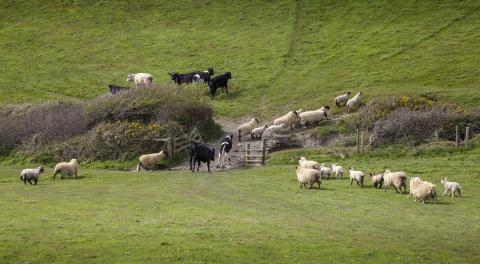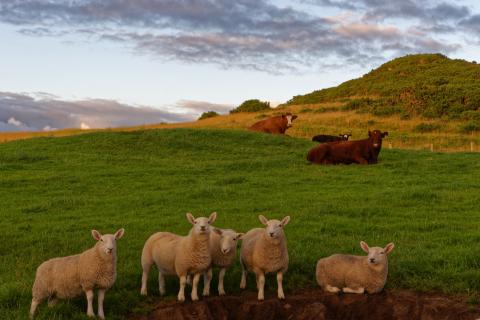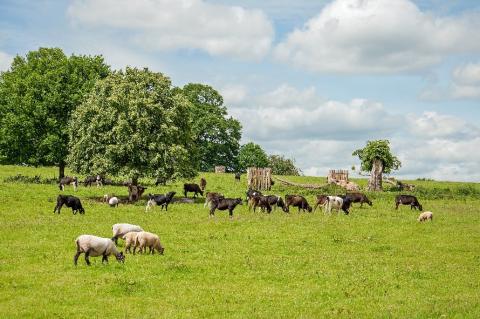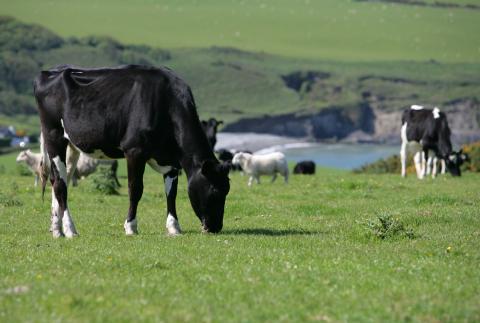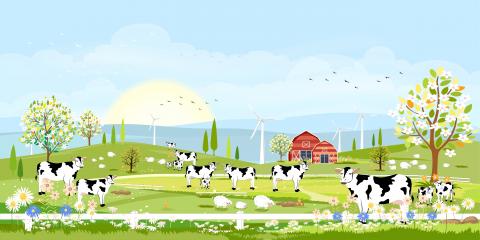14 April 2021
Dr William Stiles: IBERS, Aberystwyth University.
Take home messages:
- Mixed grazing systems can increase ruminant production potential
- Grazing multiple species of herbivore either simultaneously or consecutively can increase pasture usage efficiency and reduce parasite burdens
- This can increase grassland-ruminant system outputs without increasing fertiliser usage or land management intensity
Improving grassland management is a key objective for Welsh agriculture in order to maximise production potential to meet growing and future demands for food. Most strategies for improvement focus on enhanced management, such as introducing technologies for growth monitoring or fertiliser strategies, yet certain low-tech, even potentially traditional, approaches may also offer benefit for production outcomes.
Mixed grazing systems are where two or more herbivorous animals graze the same land, either simultaneously or consecutively. Mixed grazing approaches offer an alternative to other forms of pasture management and can be effective at increasing ruminant performance.
This positive effect occurs as the result of interactions between grazing animals. Different herbivore species have different grazing strategies. This can include preferential forage behaviour, where certain plant species are either favourably selected or actively avoided, and/or mechanical action, which is the differential effect of bite size or trampling impact between herbivores of varying size. Large herbivores such as cows can trample vegetation and take larger, less-specific bites when grazing, whereas smaller ruminants such as sheep are much more selective and less heavy footed. These factors together can result in some beneficial effects, both in terms of production and also in terms of habitat quality and biodiversity.
Research on natural systems that host multiple herbivore species simultaneously, has shown that different animal species are influenced by vegetation species in a variety of ways. This mechanism results in niche separation between herbivore species, allowing for grazing complementarity. All grazing animals exhibit selective behaviour when foraging. Several factors will affect plant and plant-part selection when feeding, including the nutritional and potentially medicinal qualities f forage. One key factor differentiating large and small herbivores is forage energy content. Smaller herbivores require more energy per unit of body size, whereas larger grazers require a greater overall energy amount (defined by the animal metabolic requirement to gut ratio: MR/GC). As such, smaller herbivores are typically more selective (quality driven) and larger herbivores are able to consume greater amounts of fibre (quantity driven).
Cultivated swards may offer less opportunity for selectivity in forage behaviour, which may reduce the potential benefits of complementary pasture use. Nevertheless, even in such scenarios there are benefits to be had in terms of increased pasture usage and factors such as reduced parasite burdens.
Mixed grazing effects on productivity
Grazing animals such as sheep and cows simultaneously or consecutively can offer benefits in terms of overall production potential. These increases in performance are the result of multiple factors which can occur synchronously and interact to offer overall advantage.
In terms of improved pasture utilisation, cattle will browse on vegetation that sheep actively avoid, including the more mature forage that is undesirable to sheep, which makes better use of all available vegetation biomass. Cattle are also more able to disturb large patches of mature vegetation that sheep will otherwise avoid and this disturbance may lead to regrowth of more palatable forage that sheep can then utilise. Cattle and sheep both avoid grazing in close proximity to dung patches of their own species, but sheep will graze in close proximity to cattle dung patches, which increases pasture usage. Through such mechanisms a more even pasture utilisation is achieved and grazing efficiency is improved.
Certain benefits have also been described in terms of reduced gastrointestinal parasite burdens, but this is variable across environments and species types. The benefits derived in terms of reduced parasite burdens stem from the disruption to parasite life cycles, reducing
overall load on pasture. Grazing cows and sheep sequentially has been reported to be effective at reducing parasite burdens in lambs in the post-weaning period, but the effectiveness of this approach on the same pasture in the long-term (multiple years) is less clear. Furthermore, in the same study, lamb performance was higher in concurrent mixed grazing rather than sequential, suggesting that the influence of parasites is only one element affecting overall sheep production potential.
Similar benefits have been reported for other mixed grazing scenarios. Horses co-grazed with cattle have been shown to suffer less strongyle infection, which is a major issue for horse breeders, and goats grazed alongside cattle resulted in lower overall parasite infections for both species. However other studies have found goats co-grazing with cattle had no influence on faecal egg count data, thus a range of site and environmental factors are also likely to play a key part.
Generally speaking, sheep are better at exploiting the advantages available from being co-located with cattle in mixed systems. In fact, in some circumstances, the benefits expected from rearing sheep with cattle in mixed grazing systems may have an adverse effect on cattle production if the two species become competitive. In such scenarios sheep development has been shown to be unaffected, but cattle development may become restricted, suggesting that larger herbivores are more susceptible to changes in sward height and condition.
Mixed grazing effects on biodiversity
Smaller grazing animals, such as goats and sheep, exhibit highly preferential forage selectivity, which can have an adverse influence on grassland community composition. By virtue of pressure from preferential selection, favoured plant species can be reduced in abundance, reducing local plant diversity. This can also diminish sward quality, as the species which remain are less preferential and therefore less desirable in terms of forage quality.
An example of this effect is the spread of unfavourable grasses in the Welsh uplands such as purple moor-grass (Molinia caerulea) and matgrass (Nardus stricta). In the case of the latter, this tough grass is avoided by sheep due to its high silica content which wears teeth. Over time, the avoidance of this grass in sheep-only systems has offered a competitive advantage which has resulted in increasing presence in upland grass swards, to the detriment of those swards.
The introduction of larger herbivores such as cattle into these systems can reduce this effect. Cattle are less selective grazers and will browse on Molinia and Nardus. Their larger, heavier tread will also act to break up Molinia and Nardus tussocks, reducing competitive exclusion and increasing floristic diversity and habitat quality.
Studies which have considered the effect of grazing on vegetation diversity have shown relationships to herbivore and environment type, both independently and as an interaction. The two principal predictive models (Intermediate Disturbance Hypothesis, and Milchunas–Sala–Lauenroth (MSL) model) indicate that in wet regions grazing intensity drives a ‘hump shaped’ response in plant diversity, which suggests a potentially optimum amount of herbivore pressure in environments such as the Welsh uplands. Thus, grazing intensity and pressure regardless of grazer type is a key regulator of plant diversity, but this is also likely to be dependent on environmental variables such as local precipitation rates.
Mixed grazing systems also result in greater structural heterogeneity of vegetation than mono-grazing systems, due to the varying diet selection and browsing characteristics of different herbivores. This can consequently increase the availability of habitat (or micro-habitats), which can improve overall levels of biodiversity through increased resource provision. Cattle for instance, create an uneven, tussocky, sward profile, whereas sheep graze more evenly. This variation in the resulting sward structure after grazing offers a range of different micro-habitats for invertebrate species, which can increase the presence of these organisms.
Summary
Applying mixed grazing approaches can enhance pasture management and livestock production simultaneously. Grazing sheep and cows at the same time or consecutively increases pasture usage, animal growth rates, and reduces parasite burdens, particularly in sheep. In unimproved grassland, such as Welsh upland swards, it can improve grassland species diversity and reduce the invasion of unfavourable grass species which are less palatable. It can also reduce the competitive advantage of these plants in sheep-only systems.
Mixed grazing is therefore an advantageous strategy to maximise the potential of Welsh grassland systems in order to improve productivity without increasing agricultural intensity, and to reduce the potential for biodiversity loss in unimproved upland grasslands.

